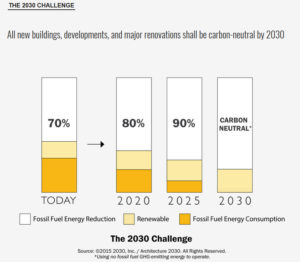Architecture 2030 and the Paris Agreement
Greetings ASHRAE members!
On January 19th I was able to attend to an event entitled “The Paris Agreement and the Built Environment” at the Pioneer Square location. There were maybe fifty our so attendees – some of whom I have been colleagues with on various projects and positions I have had over my time in the Puget Sound area.
The speaker was Andrew Lee, from Architecture 2030, who works on various outreach and education programs regarding this effort. If you want to find out more about Architecture 2030 – take a look at their website.
 Aside from some review of Paris Agreement, and what the new administration means to the US commitment – the bottomline is that it appears unchanged – the big technical take-aways for me, for my own design practice, was surprising around embodied carbon – the carbon dioxide inherent in building materials.
Aside from some review of Paris Agreement, and what the new administration means to the US commitment – the bottomline is that it appears unchanged – the big technical take-aways for me, for my own design practice, was surprising around embodied carbon – the carbon dioxide inherent in building materials.
As an HVAC design engineer and energy modeler, I have been very much aware of the amount of energy estimated to be consumed by the building stock – 44% – is what was presented here – and is what I we typically see specified. From this, the construction materials used, is responsible for about 6% of that from 2030 research.
I always thought embodied materials energy was much less than the energy used for operations. Apparently, this is not quite correct.
According to Architecture 2030, research indicates that today 75% of any given buildings life cycle carbon is embodied in the materials. That is with today’s code compliant building. There are some goals of reduction – 50% of this level by 2030 is what is proposed.
In any case, it is of much larger magnitude than I had previously thought – and it may have some ramifications to our energy related work, as we often in our work focus on our systems, and how WE can reduce the energy use.
Take a look at their presentation, it is attached at the end of this post, and their research support if you are interested in more.
Another topic of interest from the presentation was some discussion of the notion of “federal preemption” within the energy code legislation. It made me want to look into to that a little.
Many of us work with the energy codes every day. The presentation gave the impression that the energy codes are prevented from getting any more stringent . This did not sit as quite correct with me – certainly since the mid-90’s there has been lots of energy code revisions and they have always gotten stronger. So my question is – so what gives? So I am going to look into that a little and post on that.
Anyone who knows more feel free to email me at sustainability@pugetsoundashrae.org.
Education Opportunities
There are several very good e- and inexpensive continuing education courses around these topics at the AIA online university. To start an understanding – recommended is “AIA+2030 Online Series Course 1: The 2030 Challenge: Goals and Design Processes”. This is part of a series. They run an hour in length, work for continuing ed for GBCI and others, and are $40.
Also available are classes on EUI, uses of energy modeling – from an architectural design perspective, and Zero Energy Buildings
All great stuff!
[pdf-embedder url=”https://pugetsoundashrae.org/wp-content/uploads/2017/02/AIACOTE-20170119-ALEE.pdf”]

